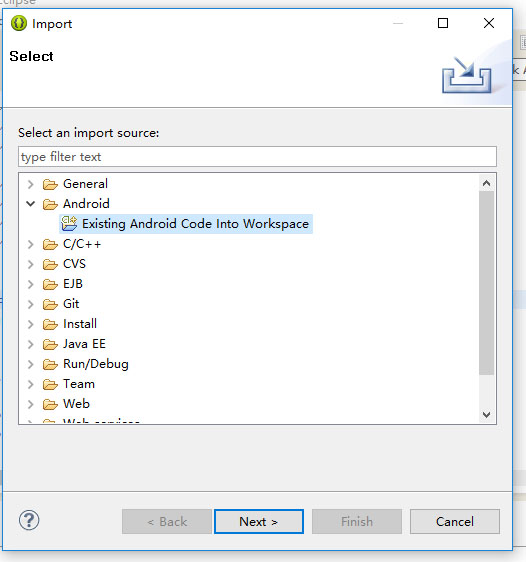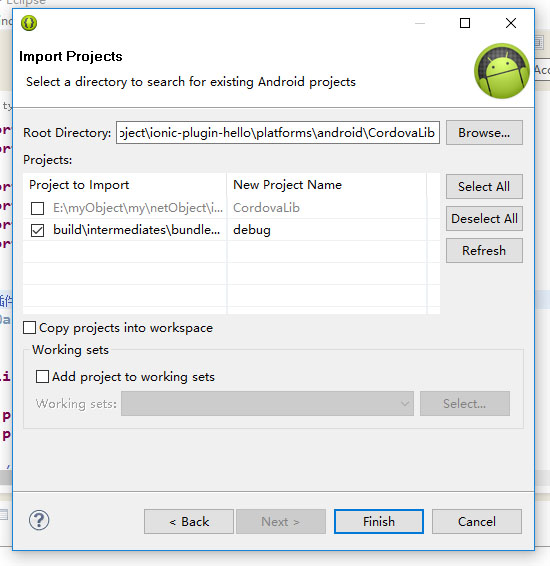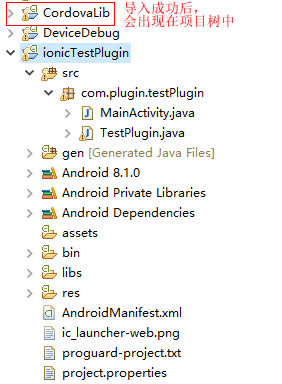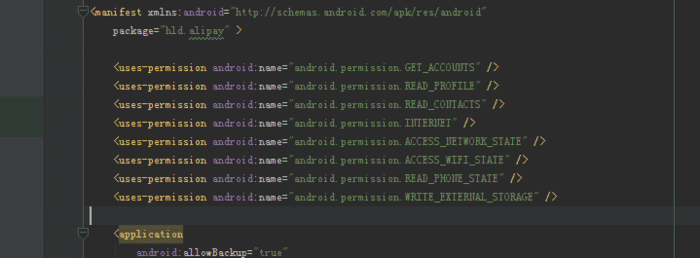一.创建一个android项目,编写插件功能,并测试ok,这里以一个简单的调用原生Toast.makeText为例。
1.新建android项目

2.编写插件类
package com.plugin.testPlugin; import org.apache.cordova.CallbackContext; import org.apache.cordova.CordovaInterface; import org.apache.cordova.CordovaPlugin; import org.apache.cordova.CordovaWebView; import org.json.JSONArray; import org.json.JSONException; import android.R.string; import android.app.Activity; import android.util.Log; import android.widget.Toast; /** * 插件类必须继承CordovaPlugin,(如果导入CordovaPlugin一系列包,见下面) * @author lzy * */ public class TestPlugin extends CordovaPlugin { public Activity activity;/** * 该方法会在调用execute()方法之前调用,此时用来获取activity和webView等 */ @Override public void initialize(CordovaInterface cordova,CordovaWebView webView){ super.initialize(cordova, webView); Log.i("initialize","============================"); this.activity = cordova.getActivity(); } /** * js方法接口, * js中通过调用该方法来执行原生的方法 * @param action 方法名 * @param args 参数(数组类型) * @param callbackContext 回掉 * 原生方法执行完后,会执行js中传过来的回掉方法 */ @Override public boolean execute(String action,JSONArray args,CallbackContext callbackContext) throws JSONException{ this.callbackContext = callbackContext; if(action=="hello"){ String orderInfo = args.getString(0); hello(orderInfo,callbackContext); return true; } return false; } public void hello(String hello, CallbackContext callbackContext){
//执行js中传过来的回调
if(hello!=null && hello.length()>0){
callbackContext.success(hello);
}else{
callbackContext.error("参数不能为空");
}
//原生代码,放在js回调后面,否则js回调不执行
Toast.makeText(this.activity, hello, Toast.LENGTH_SHORT).show();
}
}
3.因为编写插件需要继承CordovaPlugin,所以需要依赖cordova一系列包,编写时才不会出错,怎么做?
3.1新建一个ionic3的项目ionic-plugin-hello(如何新建,查看这篇)
3.2 执行下命令 ionic cordova run android (安装到手机 ,确保数据线已连接到电脑)
3.3执行成功后,查看该项目下文件夹E:\myObject\my\netObject\ionic-plugin-hello\platforms\android\CordovaLib
3.4在eclipse(android studio也行)中导入该文件夹,成为一个项目
File->import->



3.5 在插件项目中,添加对CordovaLib项目的依赖


到此就可以尽情的编写你的原生插件代码了。
二.创建ionic3自定义插件项目
(直接查看转载https://www.cnblogs.com/smartsensor/p/7904254.html)
4.1新建一个ionic3的插件项目,
(注意此时有点绕,刚才我们在eclipse中编写插件代码,是为了借助eclipse的开发环境,便于编写代码,这还不能算一个真正的ionic3插件)
pluman的安装(有了pluman才能创建插件项目) npm install -g plugman
创建插件项目
plugman create --name TestPlugin --plugin_id com.plugin.testPlugin --plugin_version 1.0.0
说明:
--name TestPlugin //自定义插件名称 --plugin_id com.plugin.testPlugin //自定义插件的包名 --plugin_version 1.0.0 //自定义插件版本
执行上述命令后会在Plugins文件夹下生成一个TestPlugin文件夹,并且TestPlugin文件夹内包含如下内容:
—TestPlugin |——src |——www |——plugin.xml
3 生成平台(android/ios)插件代码
进入插件的根目录,然后执行创建android或者ios的平台支持命令
cd TestPlugin plugman platform add --platform_name android
命令执行后在TestPlugin/src目录下出现了android目录,把刚才编写好的,android项目中的TestPlugin.java文件直接拷贝过来

拷贝到 TestPlugin\src\android\TestPlugin.java
并且在www文件夹下也新生成TestPlugin.js,TestPlugin.js的作用是通过js暴露插件的功能给ionic
var exec = require('cordova/exec');
exports.coolMethod = function (arg0, success, error) {
exec(success, error, 'TestPlugin', 'coolMethod', [arg0]);
};
说明:
TestPlugin //插件名称 coolMethod //方法名称
4 介绍plugin.xml
<?xml version="1.0" encoding="utf-8"?>
<plugin xmlns="http://apache.org/cordova/ns/plugins/1.0" xmlns:android="http://schemas.android.com/apk/res/android" id="com.plugin.testPlugin" version="1.0.0">
<name>TestPlugin</name>
<js-module name="TestPlugin" src="www/TestPlugin.js">
<clobbers target="cordova.plugins.TestPlugin"/>
</js-module>
<platform name="android">
<config-file parent="/*" target="res/xml/config.xml">
<feature name="TestPlugin">
<param name="android-package" value="com.plugin.testPlugin.TestPlugin"/>
</feature>
</config-file>
<config-file parent="/*" target="AndroidManifest.xml"/>
<source-file src="src/android/TestPlugin.java" target-dir="src/com/plugin/testPlugin/TestPlugin"/>
</platform>
</plugin>
说明:
id: 插件的标识,即发布安装到plugin 的 ID name:插件的名称 js-module:对应我们的 javascript 文件,src 属性指向 www/TestPlugin.js platform:支持的平台,这里仅仅用到了 android
5 初始化package.json
在ionic3项目中添加插件,所添加的插件必须包含package.json文件,网上一些生成的方式尝试失败,最后发现执行下面命令可行。
npm init
例如下面执行过程
C:\work\ionic\plugins\TestPlugin>npm init
This utility will walk you through creating a package.json file.
It only covers the most common items, and tries to guess sensible defaults.
See `npm help json` for definitive documentation on these fields
and exactly what they do.
Use `npm install <pkg>` afterwards to install a package and
save it as a dependency in the package.json file.
Press ^C at any time to quit.
package name: (testplugin)
version: (1.0.0)
description:
entry point: (index.js)
test command:
git repository:
keywords:
author:
license: (ISC)
About to write to C:\work\ionic\plugins\TestPlugin\package.json:
{
"name": "testplugin",
"version": "1.0.0",
"description": "",
"main": "index.js",
"scripts": {
"test": "echo \"Error: no test specified\" && exit 1"
},
"author": "",
"license": "ISC"
}
Is this ok? (yes) yes
C:\work\ionic\plugins\TestPlugin>
标识红色的地方,可以自定义,也可以直接回车选择默认值。
然后会在插件根目录下看到新建的package.json文件
三.创建ionic3项目,并引用自定义插件
1.创建ionic3项目
ionic start ionic-plugin-hello tabs
2.引用刚才自定义的插件
ionic cordova plugin add E:\myObject\my\netObject\TestPlugin
3 使用自定义插件
3.1 在home.html 上添加下面代码
<p>
<button ion-button color="primary" (click)="callMyPlugin()">call my plugin</button>
</p>
3.2 修改home.ts代码
import { Component } from '@angular/core';
import { NavController } from 'ionic-angular';
declare let cordova: any;
@Component({
selector: 'page-home',
templateUrl: 'home.html'
})
export class HomePage {
constructor(public navCtrl: NavController) {
}
callTestPlugin(){
cordova.plugins.TestPlugin.coolMethod("今天好运气,一老狼请吃鸡呀!",result=>alert(result),error=>alert(error));
}
}
标识红色的部分是定义cordova对象,和引用自定义插件方法
注意,这个变量的定义,是个全局的引用,表示所有的插件对象都加载进来
declare let cordova: any;
具体插件类的调用需要看被调用插件的配置文件plugin.xml中的节点
<clobbers target="cordova.plugins.TestPlugin"/>
如果这个节点被定义为
<clobbers target="BaiduTTS"/>
那么在调用时直接这样写
BaiduTTS.XXX(xxxxx);//xxxx代表方法名或者参数
4.安装到手机查看效果
ionic cordova run android
5.修改插件,多增加一个方法
自定义插件修改后必须先删除插件,然后再安装插件才可生效。
1)ionic cordova plugin list 列出所有已安装的插件 2)ionic cordova plugin remove com.plugin.testPlugin 从ionic3项目中删除插件 3)ionic cordova plugin add 自定义插件路径 安装插件到ionic3项目
执行顺序为1->2->修改代码->3
例如在插件中增加一个方法,首先修改TestPlugin/Android/TestPlugin.java
package com.plugin.testPlugin;
import org.apache.cordova.CordovaPlugin;
import org.apache.cordova.CallbackContext;
import org.json.JSONArray;
import org.json.JSONException;
import org.json.JSONObject;
/**
* This class echoes a string called from JavaScript.
*/
public class TestPlugin extends CordovaPlugin {
@Override
public boolean execute(String action, JSONArray args, CallbackContext callbackContext) throws JSONException {
if (action.equals("coolMethod")) {
String message = args.getString(0);
this.coolMethod(message, callbackContext);
return true;
}else if (action.equals("plus")) {//主方法中增加一段方法名称判断和调用的代码
int x = args.getInt(0);
int y = args.getInt(1);
this.plus(x, y, callbackContext);
return true;
}
return false;
}
private void coolMethod(String message, CallbackContext callbackContext) {
if (message != null && message.length() > 0) {
callbackContext.success(message);
} else {
callbackContext.error("Expected one non-empty string argument.");
}
}
//新增一个传入两个参数求和的方法
private void plus(int x, int y, CallbackContext callbackContext) {
callbackContext.success(x + y);
}
}
修改TestPlugin/www/TestPlugin.js代码
var exec = require('cordova/exec');
var testAPI = {}
testAPI.coolMethod = function(arg0, success, error) {
exec(success, error, "TestPlugin", "coolMethod", [arg0]);
};
//求和方法
testAPI.plus = function(arg0,arg1, success, error) {
exec(success, error, "TestPlugin", "plus", [arg0,arg1]);
};
module.exports = testAPI;
修改自定义插件package.json和plugin.xml文件的版本号
修改ionic项目home.html代码,增加一个button
<p>
<button ion-button color="primary" (click)="callTestPluginNew()">new plus function</button>
</p>
修改home.ts代码,增加一个调用方法
callTestPluginNew(){
cordova.plugins.TestPlugin.plus(3,7,result=>alert(result),error=>alert(error));
}
重新添加自定义插件后,再次重新生成apk,查看效果
ionic cordova build android
四.创建自定义插件时用到第三包
详细参考https://www.jianshu.com/p/050ed1bd4973
比如在上述插件中增加一个调用支付宝接口的方法,需要引入支付宝接口包
此时目录结构是这样的: TestPlugin------ |------src | |-----android | |------libs (我们导入了一个jar嘛) | | |--------alipaySdk-20161009.jar | | | |------AliPay.java | |------AuthResult.java | |------PayResult.java |------www | |------TestPlugin.js |-------plugin.xml anrdoid文件夹是我们自己创建的,里面的libs和java文件是我们之前项目中拷贝过来的
Alipay.java实现代码:
package com.plugin.testPlugin; import android.annotation.SuppressLint; import android.app.Activity; import android.os.Handler; import android.os.Message; import android.text.TextUtils; import android.util.Log; import android.widget.Toast; import com.alipay.sdk.app.AuthTask; import com.alipay.sdk.app.PayTask; import org.apache.cordova.CallbackContext; import org.apache.cordova.CordovaInterface; import org.apache.cordova.CordovaPlugin; import org.apache.cordova.CordovaWebView; import org.json.JSONArray; import org.json.JSONException; import org.json.JSONObject; import java.util.Map; /** * Created by Administrator on 2016/12/13. * 支付宝支付接口 */ public class AliPay extends CordovaPlugin { private Activity activity; private static final int SDK_PAY_FLAG = 1; private static final int SDK_AUTH_FLAG = 2; private CallbackContext callbackContext; @SuppressLint("HandlerLeak") private Handler mHandler = new Handler() { @SuppressWarnings("unused") public void handleMessage(Message msg) { switch (msg.what) { case SDK_PAY_FLAG: { @SuppressWarnings("unchecked") PayResult payResult = new PayResult((Map<String, String>) msg.obj); /** * 对于支付结果,请商户依赖服务端的异步通知结果。同步通知结果,仅作为支付结束的通知。 */ String resultInfo = payResult.getResult();// 同步返回需要验证的信息 String resultStatus = payResult.getResultStatus(); // 判断resultStatus 为9000则代表支付成功 if (TextUtils.equals(resultStatus, "9000")) { // 该笔订单是否真实支付成功,需要依赖服务端的异步通知。 callbackContext.success(resultInfo); } else { // 该笔订单真实的支付结果,需要依赖服务端的异步通知。 callbackContext.success(resultInfo); } break; } default: break; } } }; @Override public void initialize(CordovaInterface cordova, CordovaWebView webView) { super.initialize(cordova, webView); Log.e("initialize","============================"); activity = cordova.getActivity(); } @Override public boolean execute(String action, JSONArray args, CallbackContext callbackContext) throws JSONException { this.callbackContext = callbackContext; switch (action) { case "payV2": String orderInfo = args.getString(0); payV2(orderInfo); break; default: return false; } return false; } /** * 支付宝支付业务 * 返回ali20247 错误的原因是没有签约APP支付功能 */ public void payV2(final String orderInfo) { /** * 这里只是为了方便直接向商户展示支付宝的整个支付流程;所以Demo中加签过程直接放在客户端完成; * 真实App里,privateKey等数据严禁放在客户端,加签过程务必要放在服务端完成; * 防止商户私密数据泄露,造成不必要的资金损失,及面临各种安全风险; * * orderInfo的获取必须来自服务端; */ Runnable payRunnable = new Runnable() { @Override public void run() { Log.e("run","run"); PayTask alipay = new PayTask(activity); Log.e("orderInfo",orderInfo); Map<String, String> result = alipay.payV2(orderInfo, true); Log.e("msp", result.toString()); Message msg = new Message(); msg.what = SDK_PAY_FLAG; msg.obj = result; mHandler.sendMessage(msg); } }; Thread payThread = new Thread(payRunnable); payThread.start(); } }
这个类必须继承CordovaPlugin(重要),必须重写execute方法(重要),选择使用initialize方法。
根据支付宝官方要求在plugin.xml的<config-file target="AndroidManifest.xml" parent="/*">节点中配置权限

- 文件拷贝:
<source-file src="src/android/AliPay.java" target-dir="src/com/plugin/testPlugin/TestPlugin"/> <source-file src="src/android/AuthResult.java" target-dir="src/com/plugin/testPlugin/TestPlugin"/> <source-file src="src/android/PayResult.java" target-dir="src/com/plugin/testPlugin/TestPlugin"/> <source-file src="src/android/libs/alipaySdk-20161009.jar" target-dir="libs"/>
说明:
src:文件源,就是这个文件现在在哪。
target-dir:目标路径,就是将这个文件拷到哪里去。
这个配置就是,将:
AliPay-----------
|------src
| |-----android
下的文件拷贝到Android项目的对应位置中去(注意包名)。
无论是java文件还是jar文件甚至是xml文件,只要是Android项目中需要的文件,都按这种方式拷贝到相应的目录下面去。
